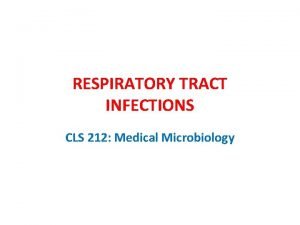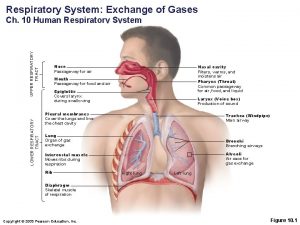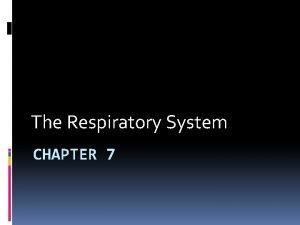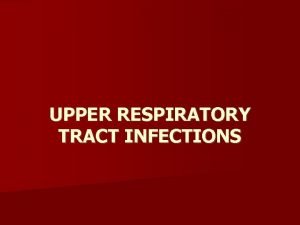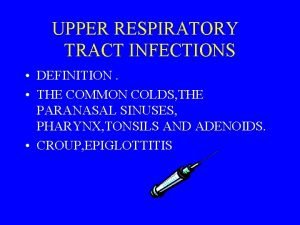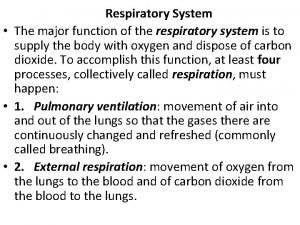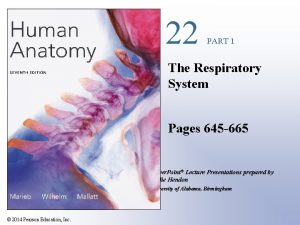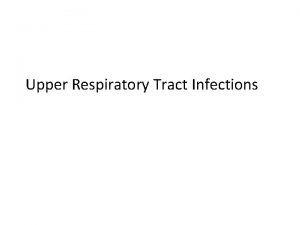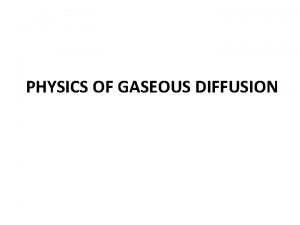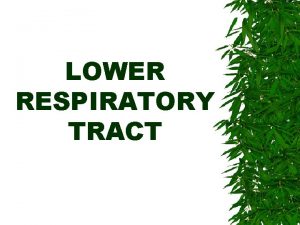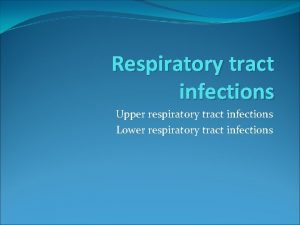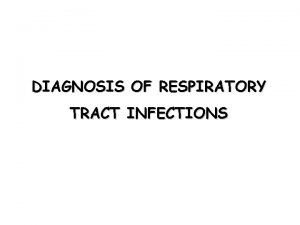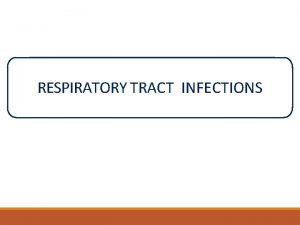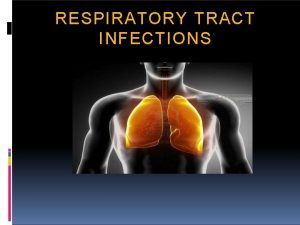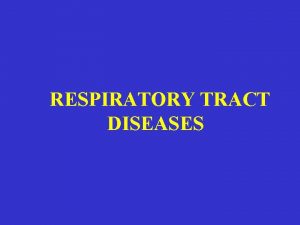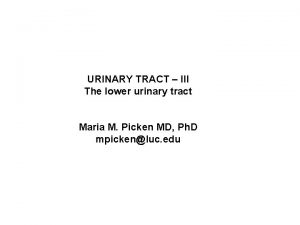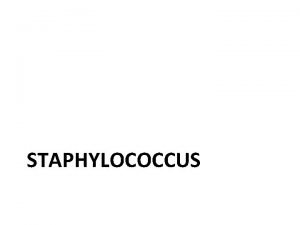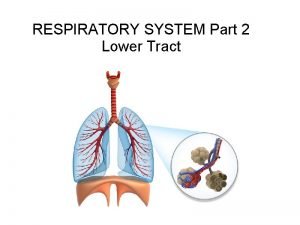Respiratory System Exchange of Gases LOWER RESPIRATORY TRACT


















- Slides: 18

Respiratory System: Exchange of Gases LOWER RESPIRATORY TRACT UPPER RESPIRATORY TRACT Ch. 10 Human Respiratory System Nose Passageway for air Nasal cavity Filters, warms, and moistens air Pharynx (Throat) Common passageway for air, food, and liquid Mouth Passageway for food and air Epiglottis Covers larynx during swallowing Larynx (Voice box) Production of sound Pleural membranes Cover the lungs and line the chest cavity Trachea (Windpipe) Main airway Lung Organ of gas exchange Bronchi Branching airways Intercostal muscle Moves ribs during respiration Alveoli Air sacs for gas exchange Rib Right lung Left lung Diaphragm Skeletal muscle of respiration Copyright © 2009 Pearson Education, Inc. Figure 10. 1

Respiration Processes § Breathing (ventilation): moving air in and out of lungs § External respiration: gas exchange between air and blood § Internal respiration: gas exchange between blood and tissues § Cellular respiration: oxygen use to produce ATP, carbon dioxide as waste Copyright © 2009 Pearson Education, Inc.

The Upper Respiratory Tract Sinuses Nasal cavity External nose Opening of the auditory tube Nostril Pharynx Tongue Epiglottis Glottis Larynx Trachea Esophagus Copyright © 2009 Pearson Education, Inc. Figure 10. 2

Upper Respiratory Tract § Functions § Passageway for respiration § Receptors for smell § Filters larger foreign material from incoming air § Moistens and warms incoming air § Resonating chambers for voice Copyright © 2009 Pearson Education, Inc.

The Lower Respiratory Tract Larynx Trachea Left bronchus Right bronchus Clusters of alveoli Copyright © 2009 Pearson Education, Inc. Bronchioles Figure 10. 3

Lower Respiratory Tract § Functions § Larynx: maintains an open airway, routes food and air appropriately, assists in sound production § Trachea: transports air to and from lungs § Bronchi: branch into lungs § Lungs: transport air to alveoli for gas exchange Copyright © 2009 Pearson Education, Inc.

Gas Exchange Between the Blood and Alveoli Copyright © 2009 Pearson Education, Inc. Figure 10. 8 a (1 of 3)

Gas Exchange Between the Blood and Alveoli Copyright © 2009 Pearson Education, Inc. Figure 10. 8 a (2 of 3) and (3 of 3)

Respiratory Cycle Copyright © 2009 Pearson Education, Inc. Figure 10. 9

Measurement of Lung Capacity Copyright © 2009 Pearson Education, Inc. Figure 10. 10 a

Gas Exchange and Transport: A Passive Process § Gases diffuse according to their partial pressures § External respiration: gases exchanged between air and blood § Internal respiration: gases exchanged with tissue fluids § Oxygen transport: bound to hemoglobin in red blood cells or dissolved in blood plasma § Carbon dioxide transport: dissolved in blood plasma, bound to hemoglobin, or in the form of plasma bicarbonate Copyright © 2009 Pearson Education, Inc.

How O 2 and CO 2 are Transported in Blood Copyright © 2009 Pearson Education, Inc. Figure 10. 12 (1 of 2)

How O 2 and CO 2 are Transported in Blood Copyright © 2009 Pearson Education, Inc. Figure 10. 12 (2 of 2)

Regulation of Breathing: Nervous System Involvement § Respiratory center in the medulla oblongata § Establishes basic breathing pattern § Chemical receptors § Monitor carbon dioxide, hydrogen ions, and oxygen levels § Medulla § Sensitive to hydrogen ions in cerebrospinal fluid resulting from carbon dioxide in blood Copyright © 2009 Pearson Education, Inc.

Regulation of Breathing Copyright © 2009 Pearson Education, Inc. Figure 10. 13

Disorders of Respiratory System § Reduced air flow § Asthma § Emphysema § Bronchitis Copyright © 2009 Pearson Education, Inc.

Disorders of Respiratory System § Infections § Pneumonia § Tuberculosis § Botulism Copyright © 2009 Pearson Education, Inc.

Disorders of Respiratory System § Lung cancer § Congestive heart failure § Cystic fibrosis Copyright © 2009 Pearson Education, Inc.
 The upper airways
The upper airways Lower respiratory tract
Lower respiratory tract Upper and lower respiratory tract
Upper and lower respiratory tract Difference between pyramidal and extrapyramidal tract
Difference between pyramidal and extrapyramidal tract Olivospinal tract vs tectospinal tract
Olivospinal tract vs tectospinal tract Lower respiratory system
Lower respiratory system What is the conducting zone of the respiratory system
What is the conducting zone of the respiratory system Classification of upper respiratory tract infection
Classification of upper respiratory tract infection Nose to lungs passage
Nose to lungs passage Anatomy of the upper respiratory tract
Anatomy of the upper respiratory tract Steeple sign
Steeple sign Upper rti
Upper rti What is the major function of the respiratory system
What is the major function of the respiratory system Structure of the upper respiratory system
Structure of the upper respiratory system Lrti
Lrti Normal flora of respiratory tract
Normal flora of respiratory tract Circularory system
Circularory system Diffusion of gases across respiratory membranes:
Diffusion of gases across respiratory membranes: The actual exchange of gases occurs at the site of the
The actual exchange of gases occurs at the site of the

